At the outset I extend my grateful thanks to the very kind invitation extended by Dr.Andrea Luithle-Hardenberg and her very concerned efforts to persuade me to attend this distinguished International Tuebingen Workshop on a very important topic The Jaina and the British. However owing to my physical disability I would not be able to make the trip to the University of Tuebingen to participate in this important Conference as medically advised. I extend my heartfelt apologies to the organizers of the workshop. I have great pleasure in extending my greetings to the distinguished scholars participating in this Conference.
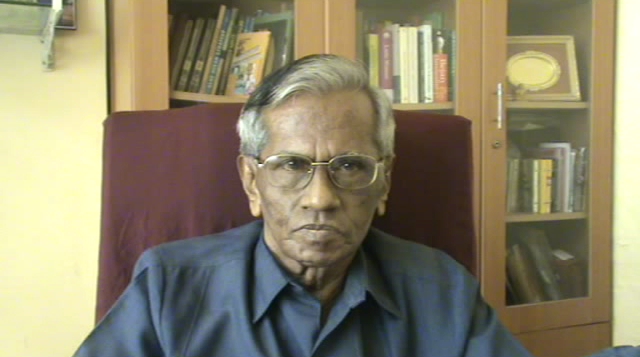 Mr. Bal Patil in his video message |
To download the video:
maximum Transferrate: 170 KB/s = 38 minutes If your internet is slower it will take accordingly longer. |
I took German as a second language almost as an intuitive choice. Little did I know that I would be having an opportunity to translate Dr.Alsdorf’s book asked by my mentor in Jain studies, Dr.A.N. Upadhye a great Prakrit Jain scholar a former President of the All-India Oriental Conference and also General Editor of the renowned Bharatiya Jnana Pitha publications. Moortidevi Jain grandthmala.
It has launched me on a German voyage of Indology - not an indologist myself - but translator of eminent Indological authors such as Prof. Dr. Ludwig Alsdorf, and Prof. Dr. Colette Caillat, (I translated from French her Le Jinisme, published as Jainism (Macmillan) which brings me to this Tuebingen Seminar! I read Albert Schweitzer’s My Life and Thought and was much impressed by his book Indian Thought and Its Development, and particularly his observation on the pioneering role of Jain ahimsa in human history.
I am proud to state that my translation of Dr. Ludwig Alsdorf’s German Beitraege zur Geschichte von Vegetarismus und Rinderverehrung in Indien (History of Vegetarianism and Cow Veneration In India) will be published (Routledge, London) in Feb. 2010 edited by Prof. Dr. Willem Bollée.
Dr. Schweitzer speaks in glowing terms of the principle of Ahimsa non-violence as laid down by Jainism: “The laying down of the commandment not to kill and not to damage is one of the greatest events in the spiritual history of mankind. Starting from its principle, founded on world and life denial of abstention from action, ancient Indian thought and this is a period when in other respects ethics have not progressed very far reaches the tremendous discovery that ethics know no bounds. So far as we know this is for the first time clearly expressed by Jainism.”
The principle of ahimsa (non-violence) and the prescription of strict vegetarianism are the prime and unique characteristics of Jain religion and ethics. That the concept of ahimsa was foreign to Vedic culture is shown by the eminent Indologist Prof. W. Norman Brown in his Tagore Memorial Lectures, 1964-65, Man in the Universe:
"Though the Upanishads contain the first literary reference to the idea of rebirth and to the notion that one's action-karma determines the conditions of one's future existences, and though they arrive at the point of recognising that rebirth may occur not only in animal form but also in animal bodies, they tell us nothing about the precept of ahimsa. Yet that precept is later associated with the belief that a soul in its wandering may inhabit both kinds of forms. Ancient Brahmanical literature is conspicuously silent about ahimsa. The early Vedic texts do not even record the noun ahimsa nor know the ethical meaning which the noun later designated… Nor is an explanation of ahimsa deducible from other parts of Vedic literature. The ethical concept which it emdodies was entirely foreign to the thinking of the early Vedic Aryans, who recognised no kinship between human and animal creation, but rather ate meat and offered animals the sacrifice to the gods." (pp.53-54)
Therefore Prof. Brown concludes: "The double doctrine of ahimsa and vegetarianism has never had full and unchallenged acceptance and practice among Hindus, and should not be considered to have arisen in Brahmanical circles. It seems more probable that it originated in non-Brahmanical environment, and was promoted in historic India by the Jains and adopted by Brahmanic Hinduism."
I propose to discuss Jain minority issue as it has evolved in the last hundred years. The remarkable thing about the Jain minority issue is that it was duly noted by the contemporary British rulers as far back as in 1909. Even more significantly the Census of India has been counting the Jains as a separate religious community right from the first census in 1873. With the dawn of the Indian freedom the Jain community did present its claim for minority status to the Constituent Assembly during the formation of the Indian Constitution.
It would be also most relevant to refer here to the two one anna coins minted during the East India Company regime in 1818 depicting Bhagwan Mahavira and Bhagvan Parsvanatha.
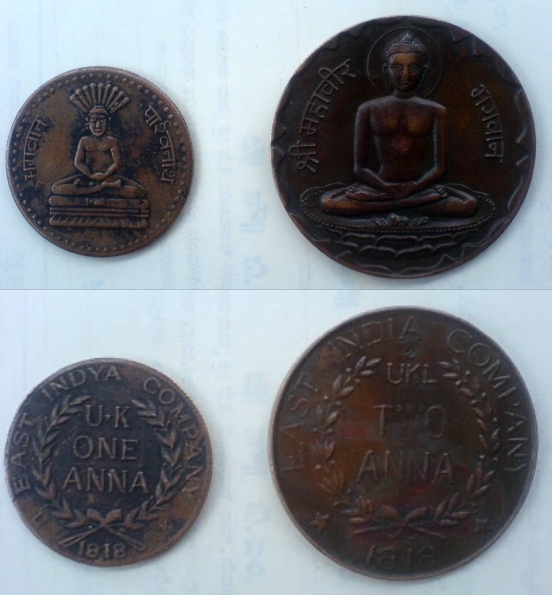
Then I would like to refer to the Imperial Gazeteer showing the British Indian Empire map in 1909 in which prevailing religions are shown as Buddhists, Sikhs and Jains. This I think as a most remarkable acknowledgment by the British India of Jainism as a distinct religious entity in India.
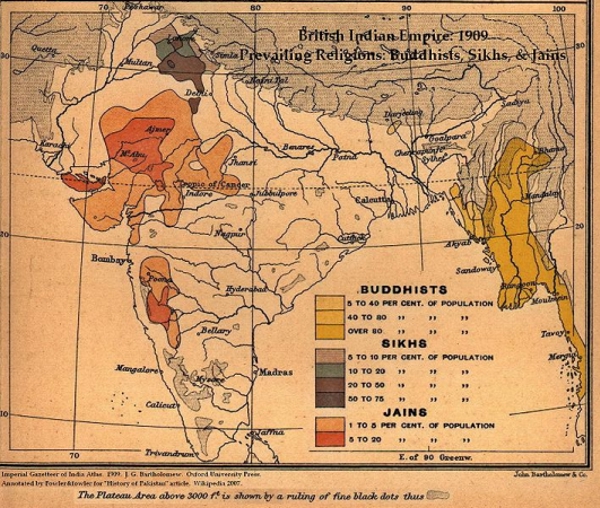
Yet the Jain leaders continued their efforts and made several representations to the non-statutory National Commission for Minorities for their designation as a national minority. Later with the enactment of National Commission for Minorities Act in 1992 Muslims, Christians, Sikhs, Buddhists and Zoroastrians (Parsis) were notified as minorities omitting inexplicably the Jains. But due to their persistent representations finally the NCM recommended for the inclusion of the Jain community but it was not notified thus by the Government.
The entire constitutional, legal and political process of the recognition of the Jain minority status is rendered confusion worse confounded by the interpretative ‘Hindutva’ parameters whether, political, religious and judicial-particularly as evidenced in the latest Supreme Court judgement in my Petition (Bal Patil & anr Vs. Union of India) which has in its obiter dicta stated that the “Hinduism is the common faith of India” and “Jainism is a special religion”.
As an extreme example I can cite the case of my complaint against the Editor, The Hindu-a prominent Indian daily- re: a report as follows:
"The Central Government's reported move to give Scheduled Caste status to Dalit Christians and Dalit Muslims will deprive current SCs (among the Hindus, Sikhs, Jains and Buddhists) of their job and education quotas, according to Vijay Sonkar, President of All India Scheduled Caste Reservation Protection Forum." Despite my complaint to the Press Council of India and the Press Council’s direction to The Hindu Editor The Hindu has not yet published my rejoinder.
Another example relates to misrepresentation of Jain Digambr community by Mr Soli Sorabjee, the former Attorney General of India, and an eminent jurist. He has tendered apology in a civil suit of defamation filed by me for having defamed the Jain Digambar religious community through comments in a column in an English daily in Mumbai in 2003. Mr.Soli Sorabjee had written in his “Out of Court” column in Times of India that “The urge to bare one’s body springs from different compulsions. a certain sect of Jains- Digambars- who move about uncovered in public invoke their right of religious freedom”. As the concerned English daily failed to publish a rejoinder objecting to its defamatory implications and as there was no response even after a complaint was lodged with the Press Council of India I filed a defamation suit in the City Civil Court. In the recent hearing on the matter it was pleaded on behalf of Mr.Sorabjee that when writing the impugned observations he had no intention to hurt or insult the religious susceptibilities of the Digambar Jain religious community, and if inadvertantly it has caused any hurt he regrets the same. Satisfied with this expression of regret I withdrew the defamation proceedings against Mr.Sorabjee, but defamations proceedings against the concerned English paper, its publishers, and the editor continue.
I am always puzzled why most historians, commentators, when they begin their search start with the phrase: ‘Jainism like Buddhism…, I cannot make out why nobody ever begins with the phrase:’Buddhism like Jainism…, Sometimes I wonder, forgive my impertinence, if there is an unwritten conspiracy to somehow bury Jainism in the historical fossils as if it is a relic of some forgotten credo of no consequence in the history of religions.
Apart from a few exceptions, most histories and encyclopaedias of world religions fail to mention Jainism as an independent religion. There are pervasive misconceptions about the origin of Jainism, about its relation to Vedic-Brahmanic Hinduism, about Mahavira being the founder of Jainism, about Jainism being an offshoot of Buddhism or Hinduism, or a reformist sect of Hinduism. There are misrepresentations galore. Jainism is overshadowed by Hinduism and Buddhism and, if noticed at all, is mentioned in passing as one of the ancient Indian religious movements subsidiary to Buddhism.
Almost all the scholars agree that Jainism has pre-Aryan roots in the religious and cultural history of India. As Dr. A. N. Upadhye remarked - “The origins of Jainism go back to the pre-historic times. They are to be sought in the fertile valley of Ganga, where they flourished in the past, even before the advent of Aryans with their priestly religion, a society of recluses who laid much stress on individual exertion, on practice of a code of morality and devotion to austerities, as means of attaining religious Summum Bonum.” (Jainism by Colette Caillat, A.N. Upadhye & Bal Patil, Macmillan, 1974)
In fact, the Jain system of thought is so wonderfully consistent with modern realism and science that one may easily be tempted to question its antiquity, about which, however, there is now no doubt. as Dr. Walthur Schubring observes, "He who has a thorough knowledge of the structure of the world cannot but admire the inward logic and harmony of Jain ideas. Hand in hand with the refined cosmographical ideas goes a high standard of astronomy and mathematics." Dr. Hermann Jacobi also believes that "Jainism goes back to a very early period, and to primitive currents of religious and metaphysical speculation, which gave rise to the oldest Indian philosophies. They (the Jains) seem to have worked out their system from the most primitive notions about matter."
In the Buddhist scripture Majjima Nikaya, Buddha himself tells us about his ascetic life and its ordinances which are in conformity with the Jain monk’s code of conduct. He says, "Thus far, SariPutta, did I go in my penance. I went without clothes. I licked my food from my hands. I took no food that was brought or meant especially for me. I accepted no invitation to a meal." Mrs. Rhys Davis has observed that Buddha found his two teachers Alara and Uddaka at Vaisali and started his religious life as a Jain.
Such is the context of the pervasive impact of the misleading Indian historiography from the deleterious effects of which even the most eminent historians, both right and left are not immune. One of the consequences of this failure is the continuing hold of misleading stereotypes of the nature of Indic religious thought and practice. I think this has a vital bearing on the devastatingly damaging impact of the misconceived Indological and ‘Oriental’ stereotypes on the Indian ethno-religious historiography so as to necessitate a paradigmatic revaluation.
This misinterpretation of history is compounded by what the doyen of Indian Indologists, Dr.R.G. Bhandarkar noted as to how “India has no written history. Nothing was known till within recent times of the political condition of the country, the dynasties that ruled over the different provisions which composed it, and the great religious and social revolutions it went through. The historical curiosity of the people was satiated by legends. What we find of a historical nature in the literature of the country before the arrival of the Mahomedans comes to very little.” P. i-ii (Early History of the Dekkan Down to the Mahomedan Conquest, 2nd Ed. 1983)
Such is the common strategy of the historians, philosophers and academicians in dealing with the Indic Sramanic religious traditions. Issues are obscured, by introducing irrelevancies and thus an attitude of contemptuous prejudice is provoked by exciting ridicule.
The Jain demand for minority status is now a century old. When in British India the Viceroy took a decision in principle that the Government would give representation to "Important Minorities" in the Legislative Council, (Petition dt.2nd September,1909,) Seth Manekchand Hirachand, acting President of Bharatvarshiya Digambar Jain Mahasabha, thus appealed to the Viceroy and Governor-General of India, Lord Minto, for the inclusion of the Jain community as an Important Minority. The Viceroy responded positively to this petition informing that in giving representation to minorities by nomination the claim of the important Jain community will receive full consideration’. Seth Maneckchand’s Petition was transferred to the Government of Bombay and the Secretary to the Govt. of Bombay stated in his reply dt.15th October,1909.2
“I am directed to inform you that a number of seats have been reserved for the representation of minorities by nominated and that in allotting them the claim of the important Jain Community will receive full consideration.”
The National Commission for Minorities Act, 1992 does not make any reference to religious minority community but defines minority for the purpose of the Act to mean a community notified as such by the Central Government, whereas, in one way or the other, Jain community has been declared as a religious minority by the various High Courts and by the State Governments pursuant to the definition given in the State’s Act or other wise.
That it may be mentioned that the Jain community has been declared as minority religious community under the various state enactments by invoking their authority under Art. 30 of the Constitution of India. But under the provision of the National Commission for Minorities Act, 1992, Muslims, Christians, Sikhs, Buddhists and Zoroastrians have been declared which lays down that minority for the purpose of the Act of 1992 means a community notified as such by the central government. There are no guide lines for such declaration. The Jain community has already been declared a minority religious community in Karnataka, M.P., U.P., Jharkhand, West Bengal, Rajasthan, Uttaranchal, Maharashtra and Delhi. In Calcutta, Delhi, Mumbai and Madras Jains have been recognized as a minority by the respective High Courts of that State. In other part of the country conditions of the Jains is the same. Thus there is proper identification on a State basis.
At the dawn of the Indian freedom the President of the Constituent Assembly Dr. Rajendra Prasad had nominated Mr. Kasturbhai Lalbhai, a Jain industrialist as a Jain representative to Minority Advisory Committee to the Constituent Assembly.
Sardar Patel in his letter of 25th August 1946 addressed to Sir Bhagchandji Soni, President, All India Digamber Jain Mahasabha assured the Jain community that “in free India there would be no restrictions upon the religious liberty of any community and there need be no apprehensions in this regard”
On 25th January, 1950, a Jain delegation was led to the Prime Minister Jawaharlal Nehru and other central leaders to draw their attention to the anomalous position of the Jains under sub-clause (b) of Clause 2 of Article 25 and a petition was submitted. Jawaharlal Nehru clearly assured the delegation that the Jains are not Hindus and on 31-1-1950, his Principal Private Secretary, Mr.A.V. Pai wrote the following letter:
"This Article merely makes a definition. This definition by enforcing a specific consitutional arrangement circumscribes that rule. Likewise you will note that this mentions not only Jains but also Buddhists and Sikhs. It is clear that Buddhists are not Hindus and therefore there need be no apprehension that the Jains are designated as Hindus. There is no doubt that the Jains are a different religious community and this accepted position is in no way affected by the Constitution."
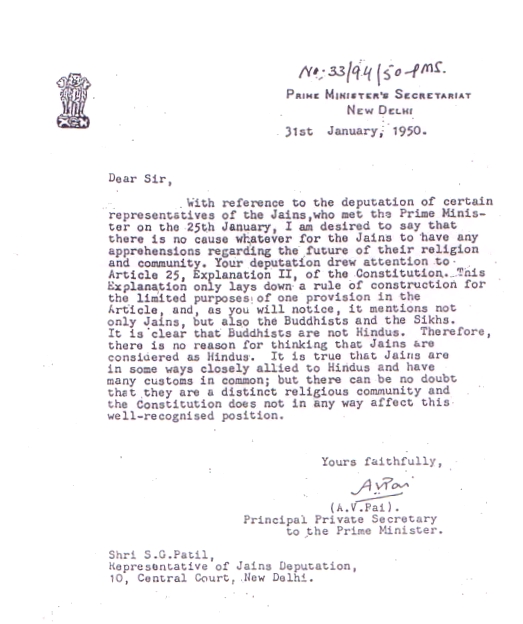
It is, however, pertinent to note in this context the insidious impact of the Hinduisation process on the Jaina population. Hinduism has never been a proselytizing religion like Christianity and Islam but the way the Hindutva propaganda is operating that Jains are Hindus the result is a surreptious conversion of Jains by their misleading enumeration as Hindus in the census. This is glaringly evident in the Census figures.
Ever since I became involved with the question of the Jain religious community as a minority I have not ceased to wonder what it is in Jainism that makes the Hindutva fundamentalists who are determined to absorb Jainism into its labyrinthine bosom, and other innocent fellow-travellers to make Jains part and parcel of their hybrid melange of diverse religious beliefs and practices. This peculiar acquisitive trend is not only confined to the well-defined agenda of the champions of ‘Hindu Rashtra’ or the Hindu nation conceived as such by Sawarkar "Asindhu Sindhu Paryanta yasya Bharatbhumika pitrubhu punyabhu sarvaih hindu iti smritah" i.e. "One who considers the country or nation spread between the Sindhu river and the sea as his Fatherland and Holy Land is verily a Hindu."-the godfather of the concept of Hindutva but also their fellow-travellers.
How did this modern myth of Hinduism begin? It had its origin in the Orientalism created by the colonial Sanskrit scholar in the 19th century. As Richard King has discussed in his book Orientalism and Religion:Postcolonial Theory, India and The Mystic East’
As he notes succinctly regarding the Constitutional clubbing of the Buddhists,Jains and Sikhs in Article 25 Expl.II which he thinks unacceptable because:
“First, it rides roughshod over religious diversity and established group- affiliations. Second, such an approach ignores the non-brahmanical and non-Vedic elements of these traditions...In the last analysis, neo-Vedantic inclusivism remains inappropriate for the simple reason that Buddhists and Jains do not generally see themselves as followers of sectarian denominationsof ‘Hinduism’.” (pp108-09)
This colonial construction of ‘Hinduism’ contributed according to Richard King to the merging of the Brahmanical forms of religion with Hinduism which is notable in the “tendency to emphasize Vedic and brahmanical texts and beliefs as central and foundational to the ‘essence of Hinduism and in the modern association of ‘Hindu doctrine’ with the various brahmanical schools of the Vedanta…”p.102
The historiographical ambiguity and the confusion worse confounded caused by such orientation caused is well documented in Prof D.N. Jha’s address to the its 66th session of the Indian History Congress as its General President: Looking for a Hindu Identity (http://www.sacw.net/India_History/dnj_Jan06.pdf.)
The 8 August, 2005 Judgment of the 3 Judges Bench of the Supreme Court consisting of Chief Justice R. C. Lahoti, Justice D. M. Dharmadhikari and Justice P. K. Balasubramanyan, in the Bal Patil Case (CA 4730 of 1999), written by Justice Dharmadhikari has not only declined to act on the recommendation of the National Commission for Minorities for the declaration of Jain community as a religious minority community on par with Muslim, Christian, Sikh, Buddhist and Zoroastrian (Parsi) but also its obiter dicta place Hindu religion above all other religions.
The Supreme Court bases its rejection of the Jaina claim for minority status on the 11 Judges Bench decision in the T.M.A. Pai Case [2002(8) SSC 481] which was related to the scope of Article 30 of the Constitution on the right of a linguistic, religious or cultural minority to establish and administer educational institutions of its choice.
In the judgment, the Supreme Court opined: "Thus, 'Hinduism' can be called a general religion and common faith of India whereas 'Jainism' is a special religion formed on the basis of quintessence of Hindu religion."
As noted by Syed Shahabuddin (IFS (Retd.), Ex-MP, Supreme Court Advocate, President, AIMMM) in his article commenting on this judgement published in the Milli Gazette Nov.3, 2005 and The Tribune, Nov.25, 2005:
"His historiography is full of flaws...All constitutional safeguards and assurances under the Constitution and in international law shall be reduced to zero if the distinct identity of any religious group, howsoever small, is denied and any group is forced to relate to Hinduism as a sect or sub-sect. The Sikhs and the Jains and the Buddhists will not accept Hindu hegemony on the ground that they are all branches of the same tree, which has sprung from the same soil. Dharmadhikari J.'s views clearly reflect the Hindutva philosophy. It is time that the Supreme Court frees itself of any lurking intellectual subservience to the Hindutva philosophy."
However, the late eminent jurist L.M. Singhvi, the Founder President of the World Jain Confederation, has observed: “The judgment in Bal Patil case is a judgment of three judges which goes against the judgment of 11 judges and many previous judgments of larger benches on the basis of which Jains must be recognised as a distinct religious minority, distinct and separate from the Hindus. Indeed, inclusive reference to Jains and Sikhs in Article 25 of the Constitution clearly indicates that Jains, Sikhs and Buddhists despite being separate and distinct were accepted as minority religions. Pt.Jawaharlal Nehru himself clarified many a times that Jains are an ancient minority. They have been recognized as a minority by notifications in Maharashtra, Uttar Pradesh and Madhya Pradesh.
The real issue now is declaration of national minority status for the Jain religious community in India. Jains have been declared a minority in Maharashtra, Karnataka, Madhya Pradesh, Uttar Pradesh, Rajasthan, Delhi, West Bengal, Uttaranchala and Jharkhand States. The total population of the Jain minority declared minority thus comes to 3,678, 551. The total Jain population in India is 4,225, 053. Thus the percentage of the Jain minority population comes to 88%. But being less than 50% to constitute a minority population in the whole of India is no longer taken into account.
The question is: Are all the benefits only meant for the national minorities so-called? I do not mean any disrespect to the national minorities so designated under the National Minorities Commission act. But I am constrained to take a strong exception to the blatantly discriminatory manner in which the Jains declared as a minority in various States such as Maharashtra, Karnataka, Madhya Pradesh, Uttar Pradesh, Delhi, West Bengal, Uttaranchala, Chhattisgarh, Jharkhand, Rajasthan comprising 88% of the total Jain population in India the Jain minority students in these States are specifically excluded from the benefit of the Pre and Post-Matriculation Scholarships announced under the Prime Minister’s 15-Point Plan in co-operation with similar State Government packages because Jains are not a National Minority!!. I am constrained to state that this smacks of being Jain Apartheid.
A meeting of the Union Cabinet, chaired by Prime Minister Manmohan Singh, on 19th December, 2008 approved a proposal to introduce the Constitution 103rd Amendment Bill to define minority. " This Bill is about the power to define a minority. The Supreme Court directed the Centre to decide the issue of giving minority status to Jains in Bal Patil vs. Union of India in 2005. A number of orders have been passed by the Supreme Court in this behalf," Home Minister, P.Chidambaram said.
It is inconceivable however that this amendment will be passed in the Indian Parliament because the main national minorities, Muslim, Christian and Sikh are not willing to arrive at a definition of minority status on the basis of State population because Sikhs are a majority in Punjab State as recently ruled by the Supreme Court of India and Christians are a majority in North-Eastern States Mizoram, Meghalaya and Muslims are a majority in Jammu & Kashmir. Besides the passage of this Bill will require two-thirds majority.
Thus Jains, Budddhists and Zoroastrians remain the national religious minorities in the real sense of the term’
Thus Jain minority matter has reached a decisive stage testing whether the Government of India has the courage to distinguish the real constitutional and demographic religious minorities from the ones declared already.
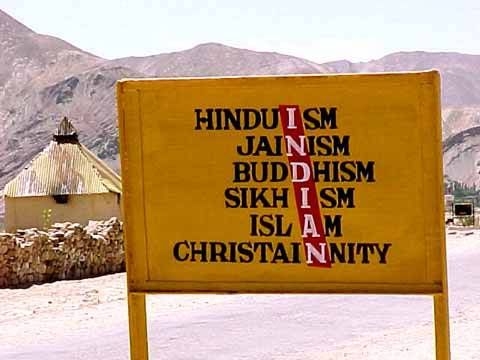
Indian Army Signpost in the Himalayas
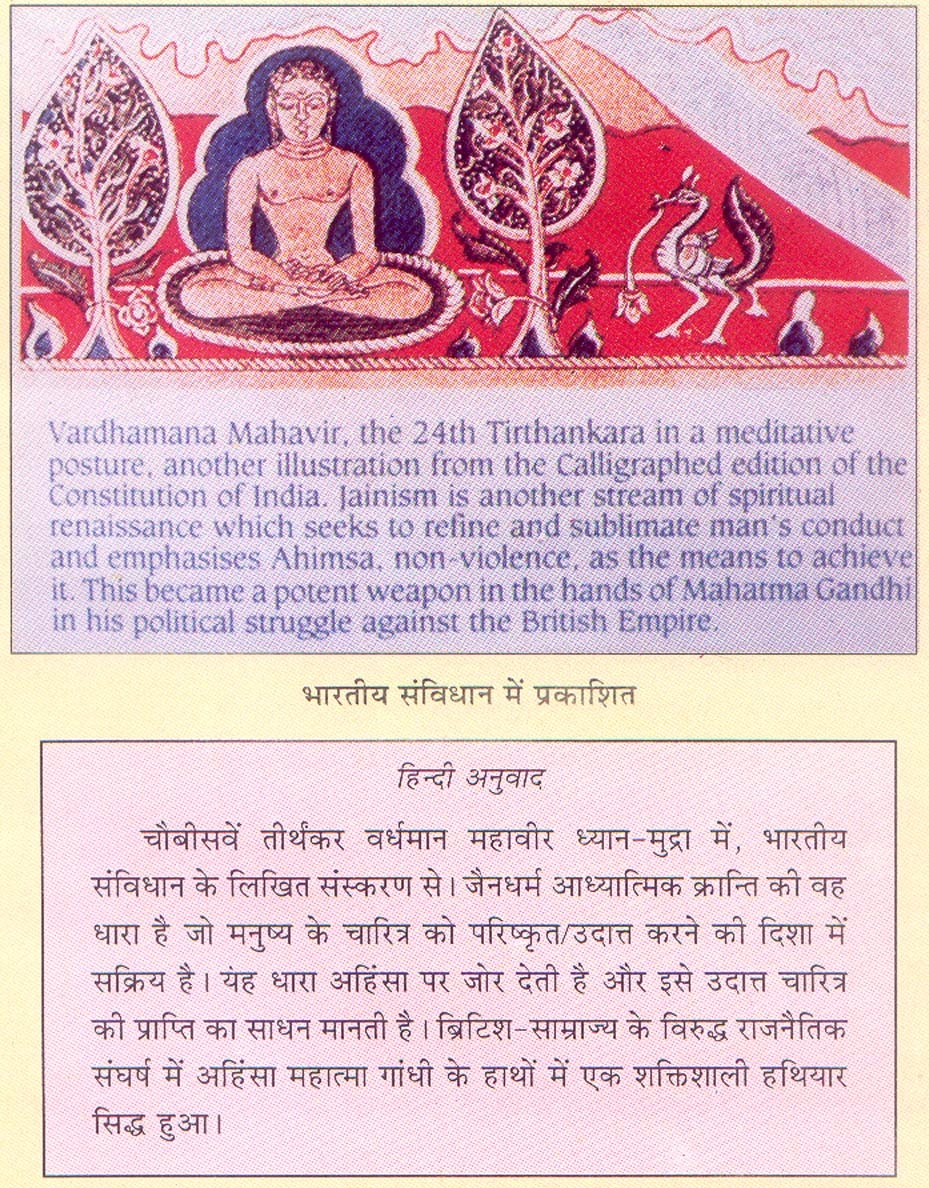
Indian Constitution/Jainism
Videos on YouTube:
 |
 |
 |
 |
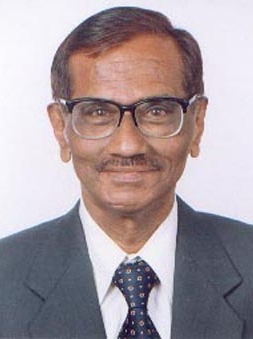 Bal Patil
Bal Patil
